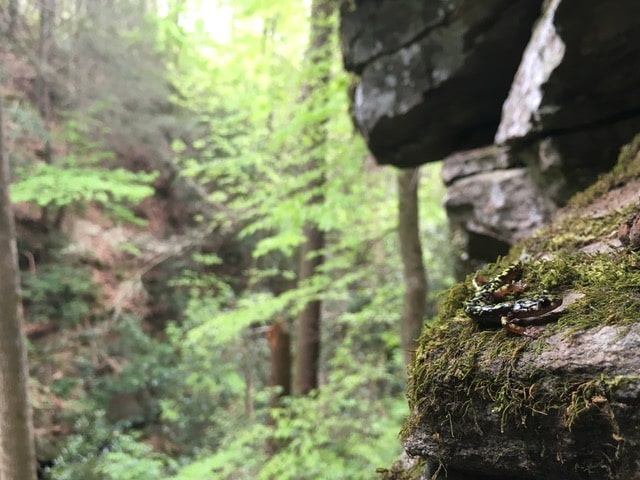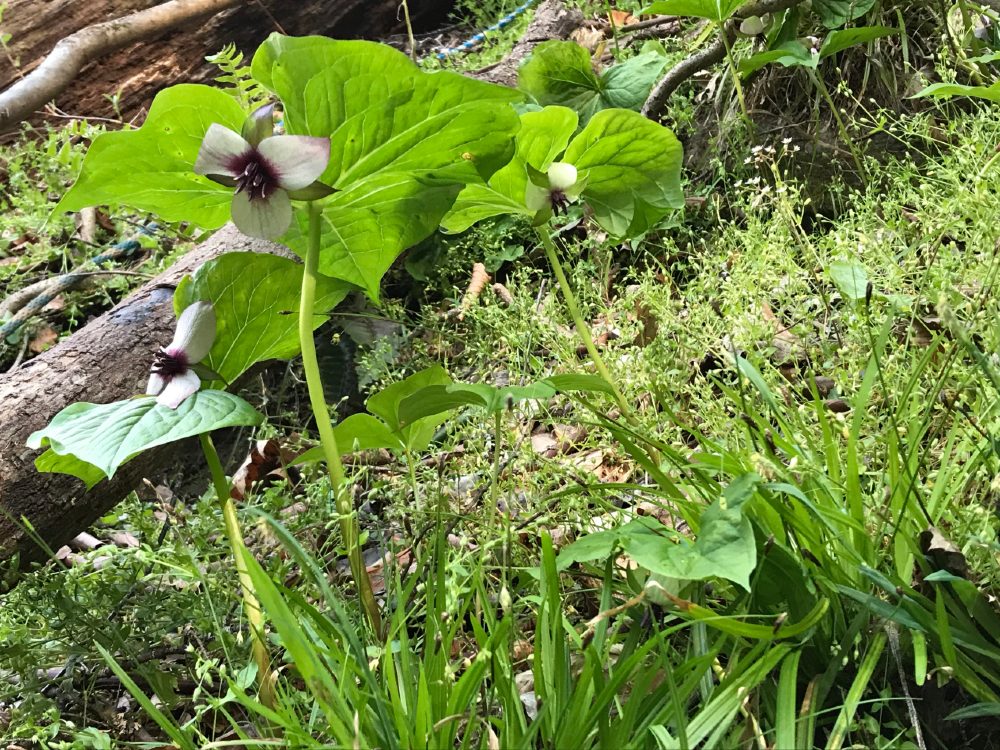Discovering a New Salamander
A biologist helps find a new species—and protect its habitat.

On a spring morning, biologist Dr. J.J. Apodaca set out with a flashlight to look for salamanders that squeeze themselves into rock crevices—and, in particular, a newly discovered salamander, the Hickory Nut Gorge green salamander. J.J. was one of the scientists who identified the species, just last year.
J.J. and two research assistants made their way through the forest, slipping on steep banks, beating back brambles, and climbing over downed trees to reach a rock outcrop by a rushing creek. Nodding trilliums, Jack-in-the-pulpits, and violets were blooming on the forest floor.
In the cracks, a glimmer could mean a salamander—a flashlight beam reflecting off its slick skin. Tiny Carolina mountain dusky salamanders wriggled along narrow cracks. Far back in a cavity was a faint glisten, which J.J. identified as a Blue Ridge gray-cheeked salamander. He teased out a crevice salamander—a fast, slippery creature as big as his hand, with dark, speckled skin. But no sign yet of the Hickory Nut Gorge green.

Winter in the Rock, Summer in the Treetops
This was the time to look—early spring when the salamanders have emerged from hibernation and are moving around the rock. Like regular green salamanders, Hickory Nut Gorge greens are arboreal—meaning they spend much of their lives in trees. As the weather warms, they climb up nearby trees and spend the warm months in the forest canopy, eating insects. Around July, females go down to stake their claims on their favorite crevices. The females compete with each other for nesting sites, defend their eggs from predators, and rub the eggs with protective secretions from their skin, until the eggs hatch months later. Then, they tend the young for another month. All the while, males remain in the treetops, returning to the rocks only in late fall when it’s time to hibernate again.
Finally, in a slim, vertical crack, J.J.’s flashlight found a flash of green—moss-green specks on a near-black body. It’s a Hickory Nut Gorge green, a salamander found only here, in the lush forests and steep, rocky terrain around Gerton, Bat Cave, and Lake Lure.

To say the Hickory Nut Gorge green salamander is newly discovered doesn’t mean that no one saw them before. People have been finding green salamanders in the gorge for ages, and those who paid close attention to salamanders could see subtle differences in the ones that you found in this part of the world. But it took genetic analysis to establish that the green salamanders in the gorge are actually a unique species.
One thing that we know about Hickory Nut Gorge green salamanders is that there used to be a lot more of them. Surveys indicate that populations have dropped about 56% in just 20 years.
J.J. says, “When we realized how different the Hickory Nut Gorge green was, we had to rush to get that news out because it’s not only so different but it’s also in so much trouble.”
Fighting for the Underdog
“I’ve always been drawn toward fighting for things that can’t fight for themselves or that not a lot of people are fighting for,” J.J. says.
As a boy in central Florida, he says, “I grew up catching amphibians and reptiles and that sort of thing and I grew up generally loving being outdoors and in nature.” In college, he started studying to be a wildlife vet. His professors got him fascinated by frogs, then salamanders. Today, J.J. is the director of conservation and science at the Amphibian and Reptile Conservancy and the founder of a consulting firm called Tangled Bank Conservation.
It was several years ago, while he was a professor at Warren Wilson College, that J.J. found himself in Bat Cave, making the case for conservation to a group of Episcopal nuns. The sisters belonged to the Community of the Transfiguration, which had long owned over 400 acres in Bat Cave as a retreat, and they were considering conservation options for their land.
“As an atheist scientist, I felt a little awkward in a room full of nuns,” J.J. says, “but we were able to connect in that this is something larger than ourselves.”
The sisters decided to protect their land as a place for learning and discovery. They protected 410 acres and conveyed most of that land to Conserving Carolina as the Teaching and Research Reserve. Last year, a neighbor added more land to the reserve, which now spans over 500 acres and borders Chimney Rock State Park. The reserve is available for students, researchers, and educational programs and it was one of the sites where J.J. and his colleagues discovered the Hickory Nut Gorge green salamander.
Cryptic Species
Green salamanders have a wide range, stretching from Alabama to Pennsylvania. But J.J. and other scientists suspected there could be unique species among them, especially considering that North Carolina’s greens were separated from other populations by the Great Smoky Mountains.
Their genetic analysis found that green salamanders in the Hickory Nut Gorge actually have significantly different DNA than their relatives—even a different number of chromosomes. “They were many times more divergent than most species are from their closest living relatives,” J.J. says. Their analysis found that Hickory Nut Gorge green salamanders have been developing independently for roughly 10-12 million years. (Compare that to a mere 400,000 years for humans.)
Last December, a team of scientists including Austin Patton, J.J. Apodaca, Jeffrey Corser, Chris Wilson, Lori Williams, Alan Cameron, and David Wake published their findings. Their paper identifies the Hickory Nut Gorge green salamander as a new species. It’s what’s known as a cryptic species—a species hidden from our eyes by its outward resemblance to its relatives.

Saving Salamanders
After 12 million years of evolution, the Hickory Nut Gorge green salamander is clinging to existence. And they’re not the only salamanders who are struggling. “Salamanders are one of the most endangered vertebrate group in the world,” J.J. says. Around 50% of the world’s salamander species are at risk.
Most salamanders don’t travel far, so they can’t easily find a new place to live when their habitat is disturbed. We don’t know how far Hickory Nut Gorge green salamanders roam, but J.J. says, “I think they’re wanderers, a little bit more than other lungless salamanders.” That’s not saying much—considering that some lungless salamanders spend their entire lives within a single square meter, moving mostly vertically through the soil layers.
Like other salamanders, Hickory Nut Gorge greens are sensitive to disruptions in habitat. They like a specific kind of place: shaded, moist rocks with cracks to shelter in, moss and lichens where they can find food, and trees growing nearby. J.J. theorizes that the loss of American chestnuts and hemlocks has been a blow to the species. Add to that the effects of air pollution on a creature that breathes through its skin, a changing climate, unknown diseases, clearings for home sites, and rock climbers who clean routes by scraping off moss and lichen—and you have a conservation emergency.
“It’s not that salamanders are completely incompatible with development or climbing or mountain biking,” J.J. says, “it’s just that you have to do it in the right place and the right way.”

“For a lot of salamanders, it’s all about protecting their habitat,” he says. “For the most imperiled species like the Hickory Nut Gorge green it’s about protecting what’s left.” These rare salamanders are found on several Conserving Carolina preserves in the Hickory Nut Gorge.
A full fifth of the world’s salamander diversity can be found in the American South and no state has more salamander species than North Carolina, with over 60. We live among a treasure trove of salamanders—but they need our care. People can help crevice-dwelling salamanders by leaving natural areas intact on and around rock outcrops. And they can help stream-dwelling salamanders by not moving rocks from their places in streambeds, where those salamanders make their homes.
J.J. says, “One important way that people can help is to support organizations that are doing work for conservation, whether that’s land trusts or wildlife groups. It’s one of the most important ways that things get done in the conservation world—you have good people working hard to conserve a species.”

This article is written by Rose Jenkins Lane as part of our our monthly Stories of the Land series which runs in the Hendersonville Times-News. These stories explore people’s connection to the land and the ways they give back to the places they love.